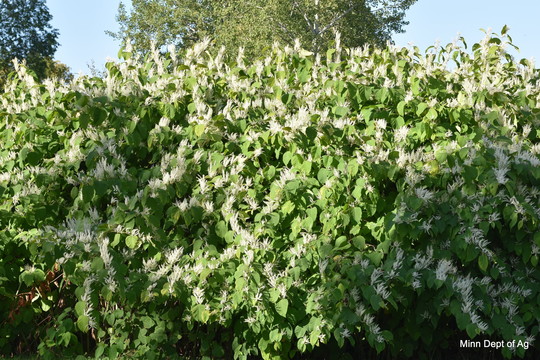|
September 8, 2020
September Weed of the Month: Invasive Knotweeds
Mari Hardel, Minnesota Department of Agriculture
It’s that time of year again - summer is coming to an end and invasive knotweeds are blooming.
In Minnesota, we have three different species of invasive knotweeds: Bohemian knotweed (Polygonum × bohemicum), Giant knotweed (P. sachalinense), and Japanese knotweed (P. cuspidatum and P. cuspidatum var. compacta). While these species do vary a little, they all look pretty similar. Knotweeds can grow to more than 12 feet tall and have large oval to heart-shaped leaves. The green stems resemble bamboo with jointed sections and will loose their leaves and turn red over the winter. Knotweed often forms dense thickets crowding out native plants and reducing habitat and also grows aggressively in managed landscapes.
 A flowering Bohemian knotweed plant.
Click here to download the image
This year, all knotweeds were added to Minnesota’s Prohibited Control Noxious Weed List. If you’re unfamiliar with the Noxious Weed List, it contains 48 species of invasive plants which are known to be “detrimental to human or animal health, the environment, public roads, crops, livestock or other property.” Species listed as Prohibited Control “must be controlled, meaning efforts must be made to prevent the spread, maturation and dispersal of any propagating parts, thereby reducing established populations and preventing reproduction and spread.”
Knotweeds spread by multiple ways, including expanding root systems and by seeds. Knotweeds also spread vegetatively which means that pieces of the plant – like stems and roots – can form new infestations when they’re broken, cut, or dug up and moved. Preventing the spread of knotweed by not moving plants is key to control. Managing populations can be an intimidating task, but when done properly and consistently, knotweeds can be significantly reduced and even eliminated. Early fall is a good time to manage invasive perennial plants (plants that live many years) because they will draw their energy, including any applied herbicides, into their root systems as they prepare to go dormant over winter.
This lifecycle shows how knotweed grows and the timing for management strategies.
Click here to download the image
Research is being done to learn best management practices for knotweeds. The Minnesota Department of Agriculture maintains webpages with information about knotweeds and management tips.
If you would like to confirm whether a plant is knotweed, you can send photos to arrest.the.pest@state.mn.us.
MEDIA: For more information on Weed of the Month, contact Allen Sommerfeld, MDA Communications, at allen.sommerfeld@state.mn.us or 651-201-6185
Having trouble viewing this email? View it as a Web page.
|